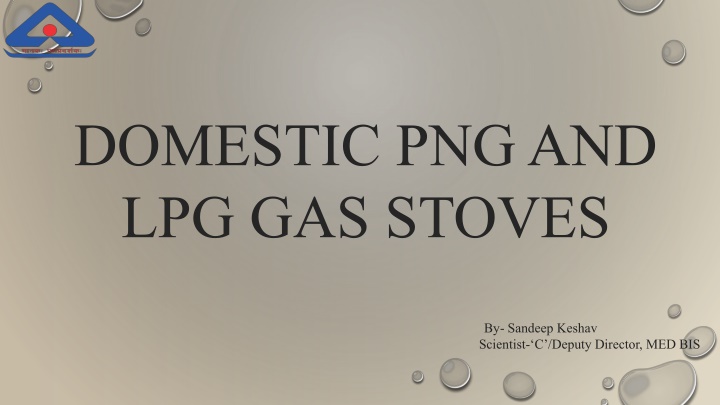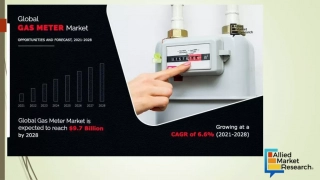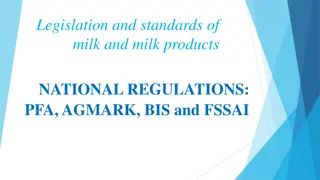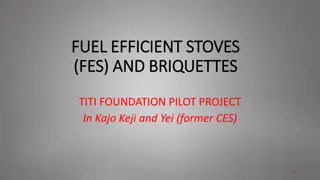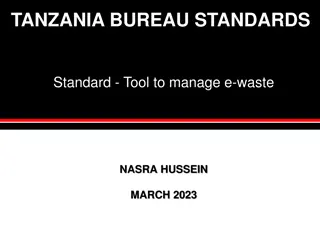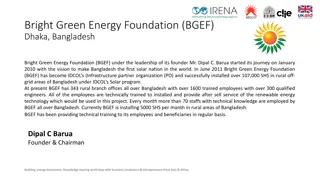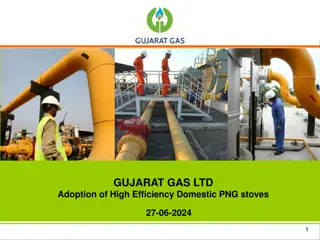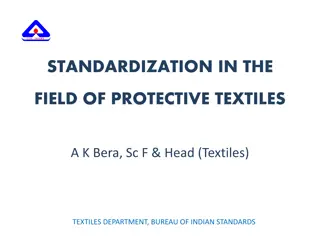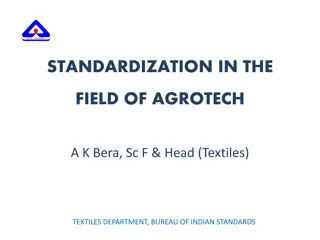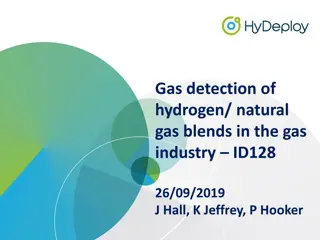Bureau of Indian Standards (BIS) - Ensuring Safety and Quality of Gas Stoves
Bureau of Indian Standards (BIS) plays a crucial role in setting and maintaining standards for domestic and commercial gas burning appliances, specifically focusing on gas stoves fueled by LPG. Established in 1947, BIS has evolved into India's National Standards Body, ensuring compliance with international practices and promoting safety, efficiency, and quality in gas stove manufacturing. Through a structured process of standards development and adherence to regulatory frameworks, BIS safeguards consumers and facilitates industry innovation in gas stove technology.
Download Presentation

Please find below an Image/Link to download the presentation.
The content on the website is provided AS IS for your information and personal use only. It may not be sold, licensed, or shared on other websites without obtaining consent from the author.If you encounter any issues during the download, it is possible that the publisher has removed the file from their server.
You are allowed to download the files provided on this website for personal or commercial use, subject to the condition that they are used lawfully. All files are the property of their respective owners.
The content on the website is provided AS IS for your information and personal use only. It may not be sold, licensed, or shared on other websites without obtaining consent from the author.
E N D
Presentation Transcript
DOMESTIC PNG AND LPG GAS STOVES By- Sandeep Keshav Scientist- C /Deputy Director, MED BIS
Indian Standards Institution 1947 BIS Act 1986 BIS Act 2016 BRIEF HISTORY BIS The Indian Standards Institution (ISI) was set up in 1947 as a Registered Society Under a Government of India Resolution. Bureau of Indian Standards (BIS) Act, 1986 Gave Statutory Status to BIS on 1 April 1987. The BIS Act, 2016 Enforced on 12th October 2017 makes BIS the National Standards Body of India. 2
PRESIDENT Hon ble Minister of Consumer Affairs, Food & Public Distribution VICE PRESIDENT Minister of State for Consumer Affairs, food and Public Distribution STRUCTURE OF BIS GOVERNING COUNCIL ADVISORY COMMITTEES EXECUTIVE COMMITTEE FINANCE CONFORMITY ASSESSMENT DIRECTOR GENERAL STANDARDS TESTING AND CALIBRATION CONSUMER AFFAIRS TRAINING ADVISORY COMMITTEE 4 RESEARCH ADVISORY COMMITTEE
P PROCESS PROCESSOF STANDARDS DEVELOPMENTAT NATIONAL LEVEL ROCESSOF OF S STANDARDS AT TANDARDS D DEVELOPMENT AT N NATIONAL EVELOPMENT EVEL ATIONAL L LEVEL BIS procedures are compliant to WTO-TBT Code of Practice Stage 2-3: Building consensus among panel/ committee members Bureau of Indian Standards 2/28/2025 International Training Programme, 10 May 2012 Stage 3-5: Building national consensus
NATIONAL STANDARDS DEVELOPMENT Technologists/ Experts Divisional Councils Sectional Committees Panels, Sub- Committees 15 Government Bodies Industry 340 643 National Standards Academia Consumers Total Experts >10000 BIS provides secretariat for standards formulation
MED 23 : DOMESTIC AND COMMERCIAL GAS BURNING APPLIANCES Scope: Domestic and Commercial Gas Burning Appliances (Pressure Type) Such as Gas Stoves, Oven, Cooking Ranges and Water Heaters, Including Gobar Gas Stoves.
IS 4246 : 2002 - DOMESTIC GAS STOVES FOR LIQUEFIED PETROLEUM GASES (LPG) This standard specifies construction, operation, safety requirements and tests for domestic gas stoves with metallic bodies intended for use with liquefied petroleum gases at 2942 kN/m2 (30 gf/cm2) gas inlet pressure. The standard was first published in 1967, with the latest revision published in 2002. This standard covers aspects like Construction, Materials, Performance, and Safety Requirements of LPG stoves. Minimum Thermal Efficiency of 68% Mandated for Each Burner. The standard is under Mandatory Certification with 269 licensees.
TESTS FOR LPG STOVES IS 4246 Generally there are two type of tests for LPG stoves: A) Type Tests B) Routine Tests The Type Tests comprise of: Strength test; Gas consumption test; Flashback test for materials of burners ; Resistance to draught test; Combustion test; Fire hazard and limiting temperature test; Floor, wall, ceiling and surface temperature test; and Thermal efficiency test.
TESTS FOR LPG STOVES IS 4246 The Routine Tests comprise of: Gas Soundness test; Ignition and Flame Travel test; Flame Stability test; Noise Control test; Flash Back test; and Formation of Soot test.
PNG AND ITS CURRENT SCENARIO Natural Gas is the cleanest fossil fuels among the available fossil fuels. It is used as a feedstock in the manufacture of fertilizers, plastics and other commercially important organic chemicals as well as used as a fuel for electricity generation, heating purpose in Industrial and Commercial units. One of the biggest use of Natural gas is in cooking in domestic households through pipeline, most commonly known as Piped Natural Gas (PNG). India is Asia s second biggest energy consumer since 2008 and is set to grow faster than that of all major economies in the world. Even, natural gas consumption will grow faster than oil or coal, expanding at 1.6% a year. As per the data of Ministry of Petroleum and Natural Gas (MOPNG), in India, the total consumption of Natural gas is 148.02 MMSCMD.
PNG AND ITS CURRENT SCENARIO At present, India is the 14th largest importer of natural gas at 20,530,000,000 (cubic meters) in the world. with the development trajectory of India the demand is expected to rise and so is the import of the Natural Gas. At present there are approximately 1.3 Crore household consumers in India with 8 lakhs new users being added annually, who are mainly concentrated in the regions of Delhi/NCR and Mumbai. But this consumption demography is expected to rise exponentially with the implementation of government projects such as Pradhan Mantri Urja Ganga (PMUG). Under this project the PNG line is expanded to Uttar Pradesh, Bihar, Jharkhand, West Bengal and Odisha by laying 3,384 km Natural Gas Pipeline. Total length of pipeline under Pradhan Mantri Urja Ganga Project is approx. 3,384 km, out of which 766 km of pipeline is in Odisha state and the balance 2,618 km is in the states of Uttar Pradesh, Bihar, Jharkhand, West Bengal & Assam. At present the pipeline has been commissioned upto Barauni in Bihar.
IS 17153:2019 - DOMESTIC GAS STOVES FOR PIPED NATURAL GAS (PNG) This standard specifies construction, operation, safety requirements and test for domestic gas stoves metallic or toughened glass bodies intended for use with PNG at 21 mbar (21.41 gf/cm2) gas inlet pressure. More recent Standard, published in 2019. This standard covers aspects like Construction, Materials, Performance, and Safety Requirements for PNG stoves. The standard is under Mandatory Certification with 6 licensees.
SIMILARITIES BETWEEN IS 4246 AND IS 17153 Construction and Operation: Both standards likely cover the general construction aspects of the stoves, including materials used, burner design, and overall functionality. This ensures a baseline level of usability and functionality for domestic gas cooking. General safety requirements: A crucial similarity would be the focus on safety features like flame failure devices, leak detection, and stability requirements. Both standards likely aim to minimize the risk of accidents associated with gas stove operation.
SIMILARITIES BETWEEN IS 4246 AND IS 17153 Testing procedures: There is overlap in the methods used to assess aspects like structural integrity, functionality, and performance. Regulatory compliance: Both standards serve a similar purpose in ensuring domestic gas stoves meet specific safety and quality benchmarks. Both standards are under Mandatory Marking. Labelling and Marking: Both standards have requirements for labelling the gas stove with relevant information like model number, manufacturer details, and Safety Instructions.
NEED FOR PNG STANDARD ? Before 2019, there were no standard on gas stoves for use with PNG. All customers were given the retrofitted LPG stoves which are compliant to Indian Standard (IS) 4246 after increasing the injector jet diameter, as the delivery pressure of PNG is less when compared to LPG. However Bureau of Indian Standard (BIS) has developed and published a dedicated standard of Gas Stoves for use with PNG i.e. IS 17153 in 2019. As there were no Indian Standard many sub-standard quality of gas stoves were imported from different countries, which resulted in low efficiency as well as safety issues to the consumers. The retrofitting of the gas stoves resulted in the decrease of efficiency (less than 40%) which in turn resulted in loss of huge amount of foreign exchange of the country. The Standard Is 17153 has made at least 50% efficiency (each burner) a mandatory requirement. However, efforts are being taken by bureau of Indian Standards to make the efficiency at par with that of LPG stoves i.e. 68%.
NEED FOR PNG STANDARD ? The delivery pressure of PNG gas varies with location. Hence, arbitrarily changing the dimension of the injector jet can lead to leakage of gas, a serious safety issue. This issue has also been adequately addressed by the BIS standard IS 17153 in which it is clearly mentioned The size of the jet in liters per hour of flow of PNG at STP conditions shall be impressed upon it . These Retrofitted/Substandard burners poses safety risks due to flame flashback or incomplete fuel combustion. Also once changed, the burners cannot be reused for LPG stoves until and unless the injector is changed. Apart from the National Interest, problems gets compounded as the operating consumers are housewives/maids/servants who have comparatively less amount of awareness on this issue.
KEY DIFFERENCES BETWEEN IS 4246 AND IS 17153 Fuel Type: IS 4246: Designed for Liquefied Petroleum Gas (LPG), which is delivered in pressurized cylinders. IS 17153: Applies to Piped Natural Gas (PNG), delivered through a continuous low-pressure gas line. Gas Pressure Regulation: IS 4246 specifies higher gas pressure requirements for LPG due to its stored pressurized nature (2942 kN/m2). The regulator needs to handle higher incoming pressure for proper burner operation. IS 17153 requires lower gas pressure regulation as PNG is delivered at a constant, lower pressure through pipes (21.41 gf/cm2).
KEY DIFFERENCES BETWEEN IS 4246 AND IS 17153 Thermal Efficiency: IS 4246 As per Clause 26 of IS 4246 the minimum thermal efficiency shall be at least 68 % for each burner with correct pan supports. For this test, the net calorific value of the gas shall be employed. IS 17153 As per Clause 26 of IS 17153, the thermal efficiency shall be at least 50 percent for each burner with a pan supported correctly on the Pan supports. For thermal efficiency test the Net Calorific value may be determined through Actual Gas Composition analysis or used on the basis of the information provided by the PNG supplier. Regulatory Framework: IS 4246 - Under Mandatory Certification (269 licensees). IS 17153 - Under Mandatory Certification (6 licensees).
